How to Play the Pipe organ
The role of stops
Changing timbre
Stops are assigned names such as "Bourdon 8'" and "Flute a Chem 4". For example, the "Bourdon" in "Bourdon 8'" is the name of the timbre, and the numeric "8'" expresses the pitch of the sound.
When the organ is played, after pulling out the stop the keys of the manual are pressed. Even when the same keys of the manual are played, the timbre and the pitch of the note produced changes depending on the stops.
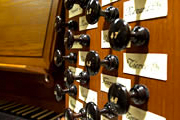
The names of each stop are written on leather labels
Let's listen to the differences between timbres
"Toccata and Fugue in D minor"
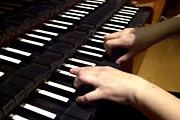
"Suite Gothique - Prière à Notre-Dame"

The first work is performed with the timbre referred to as the principal group, while in contrast the next employs the sounds known as the string group.
The four groups comprising these two in addition to the flute group and the reed pipes are the fundamental categories into which the timbres of the pipe organ are classified.
Recording combinations of timbres
A timbre can combine any number of stops. However, there may be anywhere from just a few to many tens of individual stops located to the left and right of the manuals, so it is hard for organists to change between the combinations in the brief intervals between pieces.
For that reason, in the past there were often assistant organists to operate the stops. Now electronic memory has been developed, and by pressing a single combination button a number of stops can be activated.
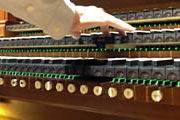
Upper manual
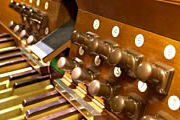
Lower manual
Below the manuals are combination buttons in line, with more near the pedalboard.
Fingertip tonguing
When the action of an organ is well-made, there will be a physical sensation of freely controlling the valves while playing the manual. The sensation felt at the fingerprints could be described as comparable to a technique for the recorder referred to as tonguing, where the tongue is placed on the mouthpiece to make each individual sound distinct.
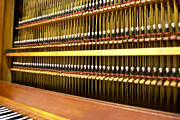
These long, thin strips of wood are the trackers, which pull the valves when the manual is pressed.
Musical Instrument Guide : Pipe Organ Contents
Origins
How to Play
How the Instrument is Made
Care and Maintenance
Trivia
- Various sizes, from large-scale to pocket-sized
- Can you tell an expensive instrument from its sound?
- Changing fashions in the number of manuals
- Partial bass range
- Delay between play and sound
- Appreciating the aesthetics of churches
- Pipe organ treasures in Tokyo
- Sound that varies according to where it is heard
